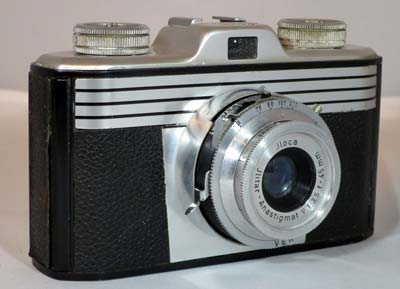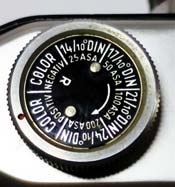Iloca Quick-A
Specification

| Manufacturer | : | Iloca |
|---|---|---|
| Produced | : | 1952 |
| Classification | : | Miniature |
| Body Type | : | Solid Body |
| Construction | : | Metal |
| Film Type | : | 135 |
| Film Width | : | 35mm |
| ImageSize | : | 36mm x 24mm |
| No. of Images | : | 36 |
| Lens Type | : | jlitar Anastigmat |
| Focus Type | : | Variable |
| Focal Length | : | 45mm |
| Focal Range | : | 3ft - inf. |
| Aperture Type | : | Iris 10 Blades |
| Aperture | : | f/3.5 - f/22 |
| Shutter Type | : | Vero |
| Shutter Speeds | : | B, 1-1/200 sec |
| Size (w x h x d) | : | 125 x 78 x 61 mm |
| Weight | : | 435g |
Art Deco Credentials
![]()
Limited: Minor and insubstantial
- Produced after the main Art Deco period.
- Horizontal decorative aluminium strips on front of body.
- Decorative trapesium shaped aluminium plate on front of body.
- Angular ends to body.
- Symmetrical design.
Description
The Iloca Quick Series of cameras was introduced around 1952. This camera is the Quick-A model. It has the film wind knob on the top plate which has a frame counter. The frame counter counts backward giving the no. of exposures left on the film. The shutter button is on the lens housing. There is an accessory shoe located on the top plate. Quick models were also available with a variety of lens and shutter configurations. This camera has a Jlitar f/3.5 lens and a Vero shutter. There is no delayed action (self-timer) device, but it has got a PC Flash contact. It has no metering and no rangefinder. It has a continuous focus ring that can vary the focus distance from 3ft to infinity. Double exposure is possible by pressing a button on the bottom whilst turning the film advance knob. While the button is pressed, the shutter is cocked but the film is not advanced.

It has a removable back giving ease of film loading. To open the back, pull the rewind knob upwards to its full extension and then twist slowly clockwise. The spring loaded mechanism will release the back. When replacing the back make sure the red dots on the camera back and the camera body are aligned. The rewind knob has an insert that allows you to set the film type in use. This has no other function than to remind you if you haven't used the camera for a while. The cameras viewfinder is a bit small but gives a fairly bright image.
How to Use
You can find the manual here:- Iloca Quick-A Manual.
Shutter speeds vary from 1/200s down to 1s. The aperture values available are f/3.5 - f/22.
If you don't want to bother with an exposure meter, follow the guide shown. It is based on the 'Sunny 16' rule. Film is so forgiving and will produce acceptable results even when overexposed by 2 or 3 stops or underexposed by 1 stop.
Remember that the exposure guide in the camera user manual may not be helpful as it is based on the use of old film with a low ISO value.
The tables assume that the sun is at least 30 degrees above the horizon - that's 10am - 5pm on a summer's day (May-August) in the UK.
If you are not sure about the light level, err on the side of overexposure - i.e. assume the smaller f number.
Where there is a choice, a larger f number will give a larger depth of field.
For the slower speeds, you may need a tripod to stop blur through shake.
Using ISO 100/125 film
| Weather Conditions | Shadow Detail | Shutter Speed (s) | |||
|---|---|---|---|---|---|
| 1/25 | 1/50 | 1/100 | 1/200 | ||
 Sunny SunnySnow/Sand | Dark with sharp edges | f/22 | f/16 | ||
 Sunny Sunny | Distinct | f/22 | f/16 | f/11 | |
 Slight Overcast Slight Overcast | Soft around edges | f/22 | f/16 | f/11 | f/8 |
 Overcast Overcast | Barely visible | f/16 | f/11 | f/8 | f/5.6 |
 Heavy Overcast Heavy Overcast | None | f/11 | f/8 | f/5.6 | f/4 |
 Open Shade Open Shade/Sunset | None | f/8 | f/5.6 | f/4 | f/3.5 |